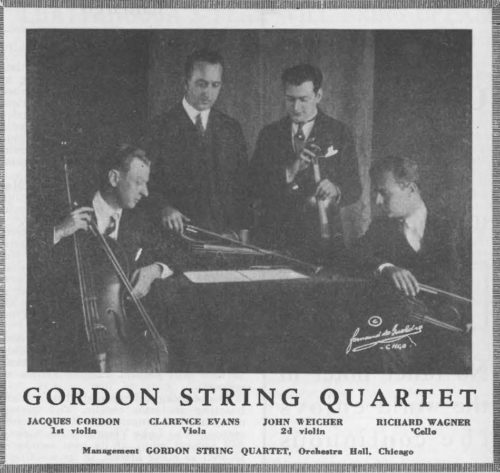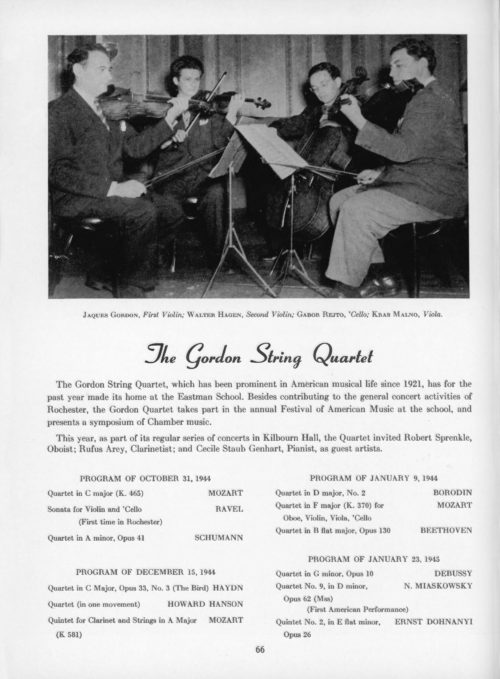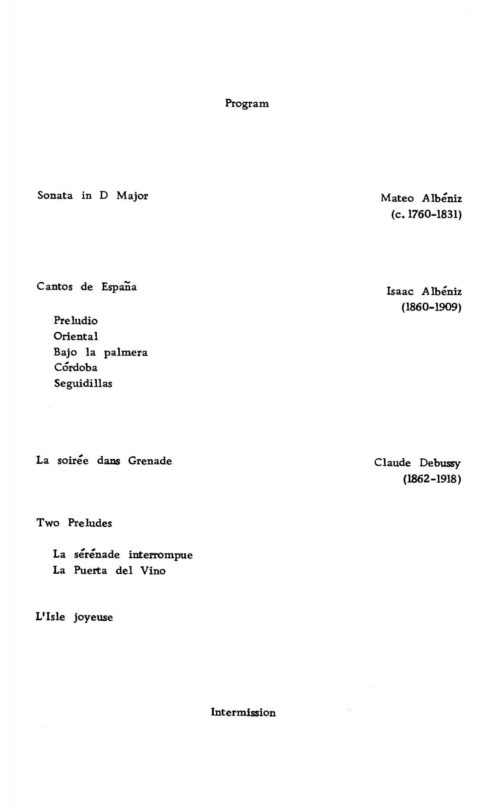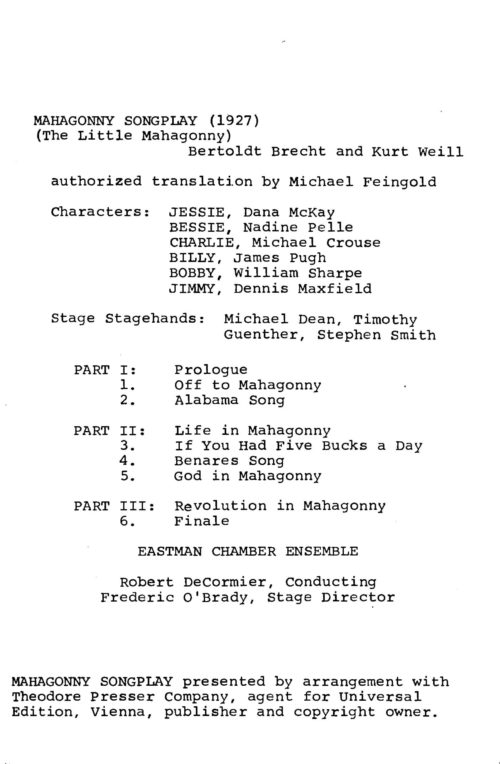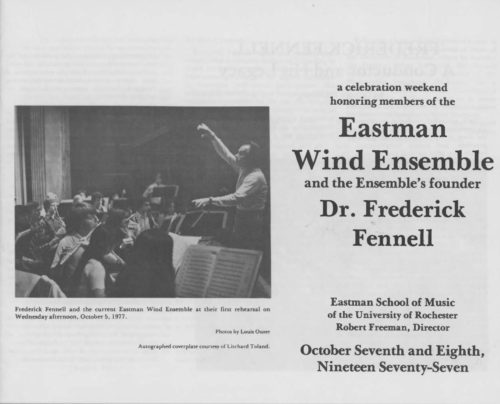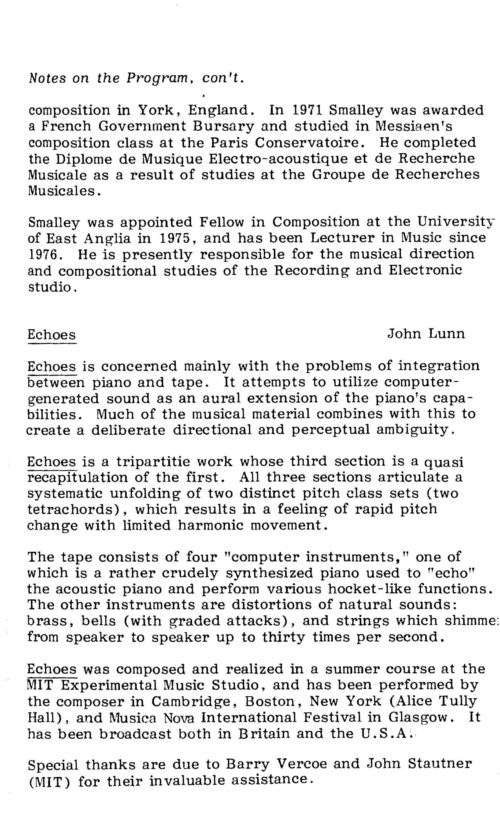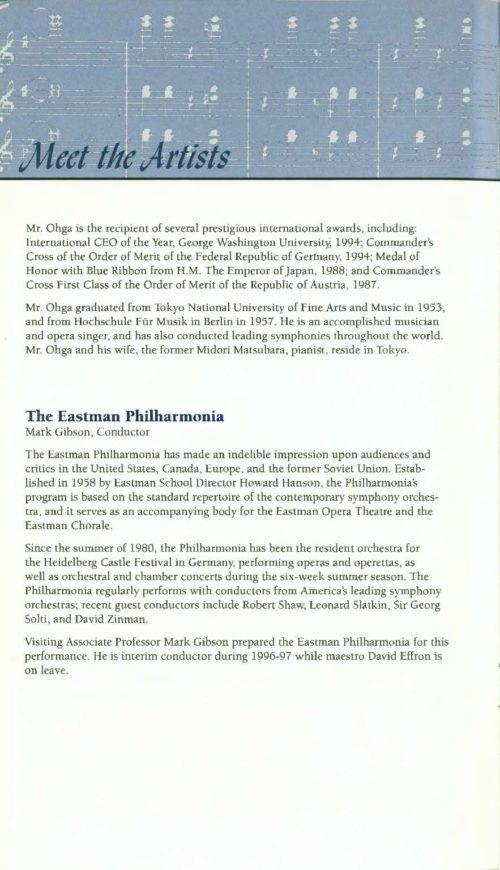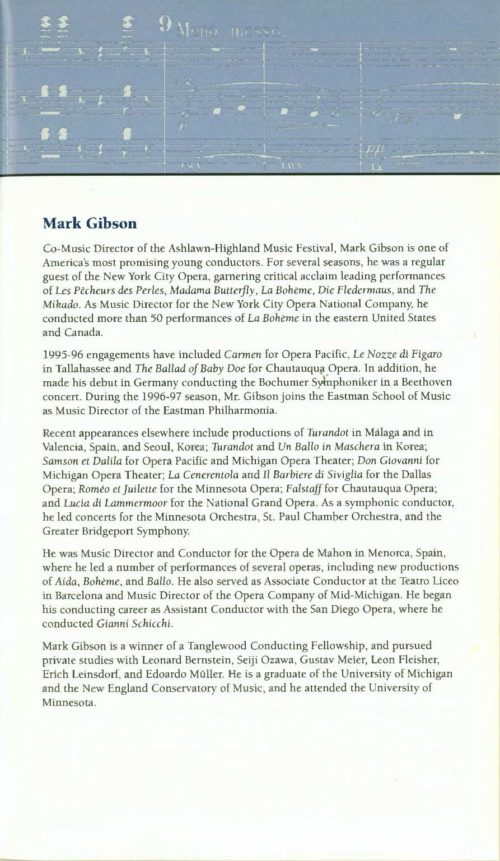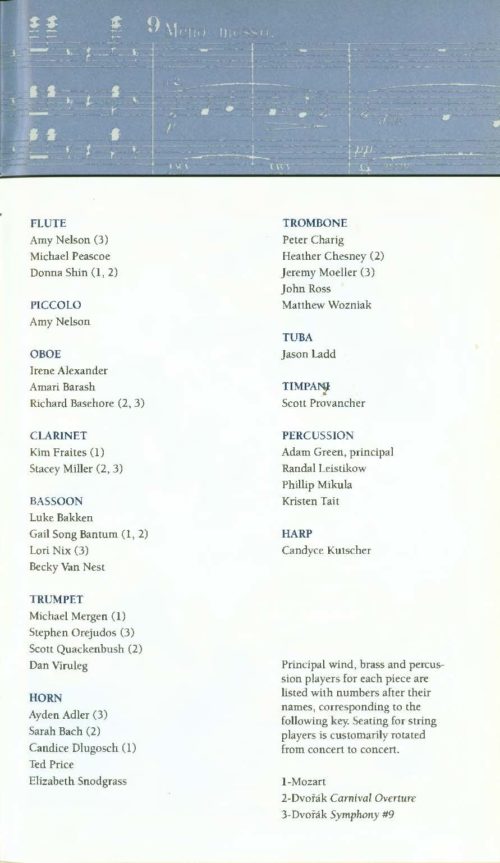Published on Oct 4th, 2021
1927: The Gordon String Quartet’s first appearance at Eastman
Ninety-four years ago this week, on October 10th, 1927, the the Gordon String Quartet made its first appearance at the Eastman School of Music in a Kilbourn Hall recital. Exactly two years later, on October 10th, 1929, the Quartet made a return engagement in Kilbourn Hall. The two recitals marked the propitious introduction to the Eastman School of an illustrious ensemble and of a remarkable violinist, an involvement that would ultimately prove hugely worthwhile for both the Eastman School and the Sibley Music Library.
► Image: Photo portrait of Jacques Gordon by Alexander Leventon, 1944. Alexander Leventon Collection
The Gordon String Quartet had been founded by Jacques Gordon, an emigré violinist whose musical life would prove multi-faceted and hugely well-rounded; he achieved success as performing violinist (in solo, chamber, and orchestral capacities), as conductor, as teacher, and as administrator. Born in 1897 in Odessa (then part of the Russian Empire; today in Ukraine), Mr. Gordon received his early musical education at Odessa’s Imperial Conservatory. He was hailed as a child prodigy, and at age 16 undertook a tour of Europe. In that same year (1913), he received a gold medal from Tsar Nicholas II on the occasion of the tercentenary of the Romanov dynasty, something that would remain one of his prized possessions. In September, 1914 he arrived in the U.S.A. and for the next three years studied with Franz Kneisel at the Institute of Musical Art in New York City. Thereafter, he served for one year as Kneisel’s teaching assistant. He thereafter relocated to Chicago and made that city the base of his activity. From 1921 until 1930 he served as concertmaster of the Chicago Symphony Orchestra under conductor Frederick Stock, and in those same years also served as head of the violin department at the American Conservatory in Chicago; and for seven years (1923-30) he served as Musical Director of the Chicago Settlement Schools. Meanwhile, in 1921 Mr. Gordon had founded a string quartet that would bear his own name, in which he would perform as first violinist, and the administration of which he would oversee.
The Gordon String Quartet’s success and national exposure throughout the 1920s eventually prompted Mr. Gordon to resign his Chicago positions in 1930 so as to focus full-time on the Quartet’s administration and performing. In addition, in 1930 he founded the Gordon Musical Association, Inc. at Falls Village, Connecticut, where he launched a summer music festival, an enterprise that continues to this day; the summer festival provided an annual venue for the Gordon String Quartet when the regular season had concluded. One printed program archived at RTWSC confirms that the Gordon String Quartet achieved that milestone that must surely be the musical equivalent of summiting Mount Everest—performing the entire cycle of Beethoven’s 16 string quartets. (On the given program, the 16 quartets were performed in a cycle of six recitals at the University of California-Berkeley in April-May, 1939.) In addition, the Quartet made numerous commercial sound recordings in the 1930s and 1940s, featuring an eclectic mix of repertory by composers Dvořák, Fauré, Hindemith, Mozart, Prokofiev, Stravinsky, Joaquín Turina, Efrem Zimbalist, and several American composers. The Gordon String Quartet’s recordings enjoyed a certain degree of success; particularly well remembered is their Decca recording of arrangements of Jerome Kern songs.
► Image: Publicity handbill for the Eastman School’s Educational Concert Series, 1927-28 season.
The recitals of October 10th, 1927 and October 10th, 1929 recitals were both given under the auspices of the Eastman School’s Educational Concert Series, which represented a mix of faculty members and renowned visiting artists. In the 1927-28 season, the Educational Concert Series included recitals by pianists Walter Gieseking and Rudolph Ganz, and by the Flonzaley Quartet. Note that the Gordon String Quartet’s October 10th, 1927 recital program included Howard Hanson’s Quartet in one movement, which was still a brand-new work, having been been composed in 1923 on a commission from the Elizabeth Sprague Coolidge Foundation, premiered at the Library of Congress in 1925, and published by C. C. Birchard in 1927. (The review by local critic Stewart B. Sabin, published in the next day’s issue of the Rochester Democrat & Chronicle, indicated that Hanson had addressed the audience to explain his Quartet, quoting him at some length.) While the programming of the Hanson Quartet might well have been an overt gesture to seek favor with the Director of the Eastman School of Music, or possibly an expression of gratitude for having been booked in the Eastman School’s concert series, the truth is that the Gordon String Quartet actively promoted works by American composers, which placed the Quartet squarely in line with Eastman’s Howard Hanson, who was busy with American music initiatives of his own, including his American Composers Concerts, just then in their second full season. Overall, Jacques Gordon’s contributions to American musical life were not going unnoticed, for in 1938 he received the Elizabeth Sprague Coolidge Medal for Distinguished Service to Music in the United States.
In 1942 Jacques Gordon was appointed to the Eastman School faculty, succeeding Gustave Tinlot as chairman of the strings faculty after the latter’s death. As violinist, Jacques Gordon performed several solo recitals, in particular performing with pianist Emanuel Balaban all of the Beethoven Sonatas for violin and piano; he was soloist with Hanson’s Eastman-Rochester Symphony Orchestra on several occasions, including a performance of the Samuel Barber Violin Concerto on April 27th, 1944; on one occasion he was soloist with the Little Symphony of Phi Mu Alpha, and on two other occasions was guest conductor of that orchestra. In 1946 Mr. Gordon achieved another mark of distinction as a concert violinist when he acquired a Stradivarius violin—the Lord Amherst Stradivarius that had previously been owned by Fritz Kreisler. A photograph of Mssrs. Gordon and Kreisler together was published in the Rochester press at that time.
Following Mr. Gordon’s appointment to the Eastman School faculty, the University of Rochester became the sponsor for the Gordon String Quartet, thereby making this ensemble the latest in the Eastman School’s succession of resident string quartets. (The first had been the Kilbourn Quartet; the successor quartet to the Gordon String Quartet would be the Eastman String Quartet.) The Gordon String Quartet would make a substantive contribution to the Eastman School’s concert life, giving 18 recitals in five successive seasons (1942-43 through 1946-47). Those 18 recitals included appearances at the Eastman School’s annual Festivals of American Music, where the Quartet introduced new compositions by American composers. On several occasions the Quartet collaborated with faculty colleagues—including pianist Sandor Vas, pianist José Echániz, double bassist Oscar Zimmerman, and flutist Joseph Mariano—in quintet literature; perhaps most notably, the Gordon String Quartet joined by pianist José Echániz gave the Rochester premiere of the Shostakovich Quintet, opus 57 on February 26th, 1946. As happens with many an ensemble, there were personnel changes over time. In 1942-43, the line-up was: Jacques Gordon (1st violin), William Nowinski (2nd violin), Bernard Milofsky (viola), and Fritz Magg (violoncello); in 1946-47, Mssrs. Gordon and Magg were still in place, while Urico Rossi played 2nd violin and David Dawson played viola.
The Gordon String Quartet’s performing activity was brought to a halt when Mr. Gordon suffered a stroke in the spring of 1947, after which he ceased many of his activities on the advice of his doctor. While officially remaining on the Eastman School faculty for the 1947-48 academic year, Mr. Gordon was obliged to resign his leadership of the Gordon String Quartet; thereafter, neither Mr. Gordon nor the Gordon String Quartet gave any further performances at Eastman. In September, 1948, Mr. Gordon suffered another stroke while at his summer home in Falls Village, Connecticut, and died shortly afterwards. (The three remaining members of the Gordon String Quartet, acting on the encouragement of Elizabeth Sprague Coolidge, regrouped and found a new performing life as the Berkshire String Quartet.)
While Jacques Gordon’s pedagogy and performance at Eastman were ended by his death, his legacy carried on in another guise. Following Mr. Gordon’s passing, the Sibley Music Library purchased his vast working library of music from his widow, Mrs. Ruth Gordon; the details surrounding that acquisition were described in an article by Sibley Librarian Ruth T. Watanabe, published in the University of Rochester Library Bulletin, vol. VII, no. 2 (winter 1952), which is accessible online.
The bulk of the collection’s holdings were catalogued and shelved with the SML’s circulating collection. Separately, a select body of material was kept apart and today forms the Jacques Gordon Collection in the SML’s Ruth T. Watanabe Special Collections. The Jacques Gordon Collection at RTWSC is noteworthy for its numerous presentation copies of works by American composers, as well as original works and arrangements by Mr. Gordon represented in manuscript. (A presentation copy is one that has been presented by its author or some other individual, and is almost always inscribed with a message to the recipient.) The finding aid for the Jacques Gordon Collection is accessible here
Thus, browsing among the chamber music literature in the Sibley Music Library’s stacks, you can find scores and parts bearing Jacques Gordon’s distinctive signature. His legacy lives on at the Eastman School of Music.









